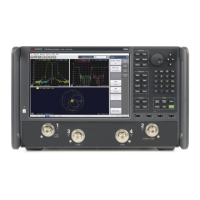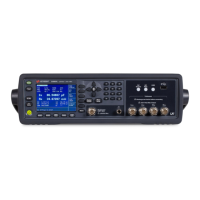4 Input/Output Functions
Input/Output
Max 100 dB
Readback Text Q Gain, <I Ext Gain> dB
Initial S/W Revision Prior to A.02.00
Restore Input/Output Defaults
This selection causes the group of settings and data associated with the Input/Output key to be a reset to
their default values. In addition, when a Source is installed, licensed and selected, Restore Input/Output
defaults will initiate a Source Preset.
This level of Restore System Defaults does not affect any other system settings or mode settings and does
not cause a mode switch. All the features described in this section are reset using this key, including Input
Corrections and Data (described in the Corrections section).
Key Path
Input/Output
Example :SYST:DEF INP presets all the Input/Output variables to their factory default values.
Notes Refer to the Utility Functions for information about Restore System Defaults and the complete
description of the :SYSTem:DEFault INPut: command.
Initial S/W Revision Prior to A.02.00
Corrections
This key accesses the Amplitude Corrections menu.
Amplitude Corrections arrays can be entered, sent over SCPI, or loaded from a file. They allow you to
correct the response of the analyzer for various use cases. The X-series supports four separate
Corrections arrays, each of which can contain up to 2000 points. They can be turned on and off individually
and any or all can be on at the same time.
Trace data is in absolute units and corrections data is in relative units, but we want to be able to display
trace data at the same time as corrections data. Therefore we establish a reference line to be used while
building or editing a Corrections table. The reference line is halfway up the display and represents 0 dB of
correction. It is labeled “0 dB CORREC”. It is drawn in blue.
Corrections data is always in dB. Whatever dB value appears in the correction table represents the
correction applied to that trace at that frequency. So if a table entry shows 30 dB that means we ADD 30
dB to each trace to correct it before displaying it.
In zero span, where the frequency is always the center frequency of the analyzer, we apply the
(interpolated) correction for the center frequency to all points in the trace. In the event where there are
two correction amplitudes at the center frequency, we apply the first one in the table.
Note that the corrections are applied as the data is taken; therefore, a trace in View (Update Off) will not be
affected by changes made to the corrections table after the trace is put in View.
Key Path
Input/Output, Corrections
EMI Receiver Mode Reference 183

